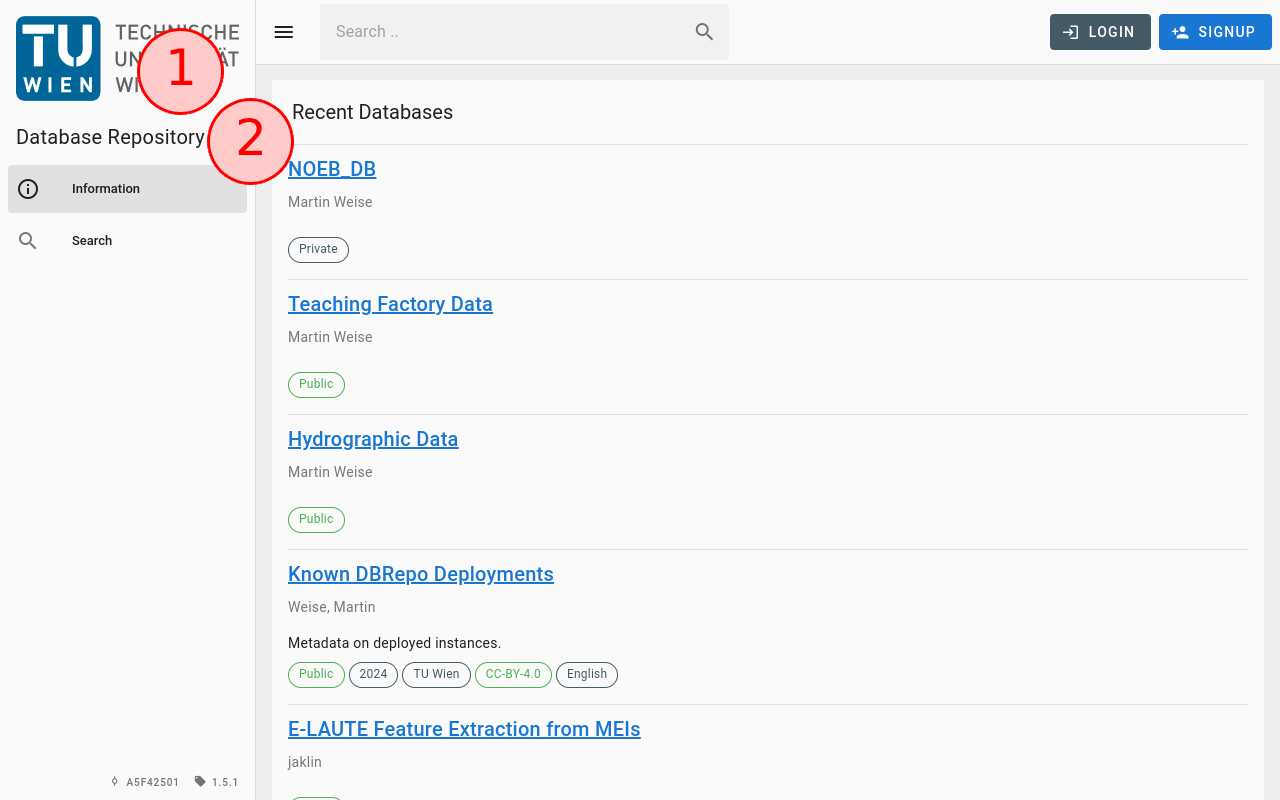Repository
tl;dr¶
Debug Information
Image: registry.datalab.tuwien.ac.at/dbrepo/ui:1.10.5
- Ports: 3000/tcp
To directly access in Kubernetes (for e.g. debugging), forward the svc port to your local machine:
kubectl [-n namespace] port-forward svc/ui 3000:80
The User Interface is configured in the runtimeConfig section of the nuxt.config.ts file during build time. For the
runtime, you need to override those values through environment variables or by mounting a .env file. As a small
example, you can configure the logo below. Make sure you mount the logo
as image as well, in this example we want to mount a custom logo my_logo.png into the container and specify the name.

Text values like the title can be configured as well via the Nuxt runtime
configuration through single environment variables or .env files.
NUXT_PUBLIC_TITLE="My overriden title"
NUXT_PUBLIC_LOGO="https://mydomain/my_logo.png"
NUXT_PUBLIC_ICON="https://mydomain/my_favicon.ico"
...
To work, you need to serve the my_logo.png and my_favicon.ico from a separate webserver. Note that simply
copying the files into the Nuxt public/ directory will
not work as the content length is calculated only during build time. The development
team #19263 does not plan to fix this.
Text values like the title can be configured as well via the Nuxt runtime
configuration through adding the logo file as ConfigMap.
kubectl [-n namespace] create configmap gateway-service-config \
--from-file=logo.png
Then you need to mount the configmap into the Gateway Service under /etc/nginx/assets/assets.
gatewayservice:
extraVolumes:
- name: config-map
configMap:
name: gateway-service-config
extraVolumeMounts:
- name: config-map
mountPath: /etc/nginx/assets/assets
All files mounted that way are accessible through svc/gateway-service:80 (or ingress if you enabled it) with prefix
/assets, e.g. https://<hostname>/assets/logo.png. Therefore, set the logo path:
ui:
public:
api:
logo: "https://<hostname>/assets/logo.png"
...
Architecture¶
The server-client architecture of the User Interface is shown below, it is supposed to help debug the User Interface on development.
- Runtime: Node.js 22 LTS
- Builder: Vite
- Server: Nuxt.js 3+
- Components: Vue.js 3+
- Frontend: Vuetify 3+
- State: Pinia
Customization¶
The UI supports adding pages in Markdown format to describe the terms of use, policies and the repository itself. Inject your content through the environment variables:
NUXT_PUBLIC_ABOUT_CONTENT(/about)NUXT_PUBLIC_POLICIES_CONTENT(/policies)NUXT_PUBLIC_TERMS_CONTENT(/terms)
If any of these environment variables are not empty, they will be displayed on the navigation and the content will be rendered.
Limitations¶
- When developing locally, the
axiosmodule does not parse custom headers (such asX-Count,X-Headers) and/or blocks CORS requests wrongfully.
Do you miss functionality? Do these limitations affect you?
We strongly encourage you to help us implement it as we are welcoming contributors to open-source software and get in contact with us, we happily answer requests for collaboration with attached CV and your programming experience!
Security¶
(none)
